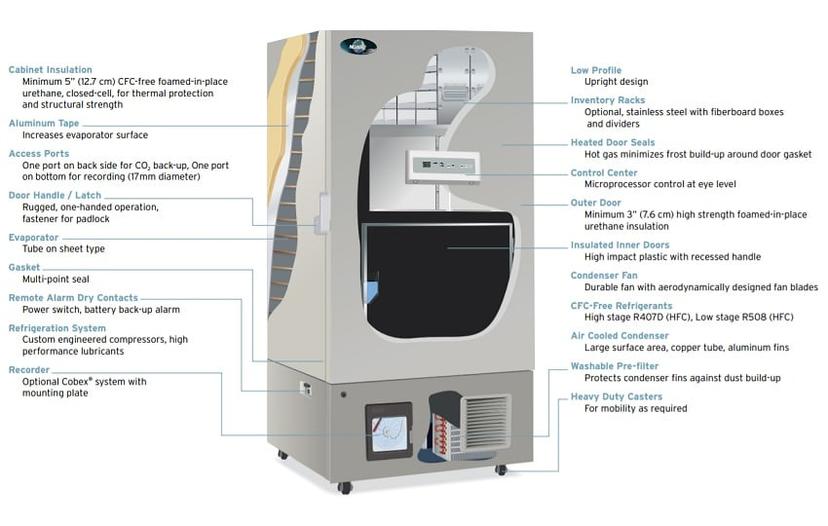10 Things to Consider When Buying an Ultra-Low Temperature Freezer
8 Dec 2016

Ultra low tempreature technology has advanced a lot in the last decade
Ultra-low temperature (ULT) freezers are a vital component of life science, pharmaceutical and clinical laboratories, where long-term sample preservation at precise temperatures is essential. ULT freezers have a service life of around twelve to fifteen years and will be responsible for the long-term preservation of your samples, so it is important to make the right purchasing decision. Freezer technology has advanced a lot in the past decade, so if you haven’t purchased a ULT freezer in a while you might find that new technology has solved some of the problems you encountered with your old model.
NuAire has produced a white paper to help you choose the right ULT freezer for your laboratory. Here we provide an overview of key considerations you should have in mind when you’re looking for a new or replacement ULT freezer for your laboratory.
1. Types of ULT freezers
There are a variety of design options available, all of which have benefits and drawbacks for certain laboratories and applications. For example, chest freezers are more efficient than the upright design, but due to space limitation in most laboratories, the upright is the more popular choice.
2. Which refrigerant?
ULT freezers using hydrocarbon refrigerants are considered much more efficient than those using conventional (HCFC) refrigerants, making them a popular choice. However, because they are flammable there are restrictions on their use in some countries.
3. Pull down and warm up time
Good manufacturers will supply data to demonstrate the pull-down and warm-up times, as well as the power consumption of the freezer. Look for features such as effective insulation, door gaskets and claw doors if you want to increase the warm-up time and use less power.
4. Hot-spots and temperature uniformity
Assess and compare the uniformity of the freezer by looking at the test data provided by the manufacturer – good data will have the test probe locations specified. Keep in mind that uniformity tends to be better when the freezer is fully loaded.
5. Capacity and footprint
Larger capacity freezers have a lower energy consumption per cubic foot, so consider sharing a freezer with another laboratory if you don’t have the need for a larger capacity freezer. Another practical consideration is internal storage – if you are going to be loading top compartments with heavy inventory racks, consider side-access draws as an alternative to pull-out drawers.
6. Location of the freezer
When deciding where to place the freezer in your laboratory don’t forget to take into account that a freezer needs minimum side and top clearance to allow air circulation. Also assess the regional air temperature in different areas of the laboratory. Another factor which is easy to overlook is the decibel rating, especially if the freezer is to be adjacent to an office.
7. Avoiding frost
Frost build-up is an inevitable nuisance when using ULT freezers, but there are many features available which can minimize build-up such as increased door insulation, claw latches and halo bypass heaters which keep the gaskets frost free.
8. Facilities
All ULT freezers require chilled process water, a reliable power supply and vacuum, and some have additional requirements such as data ports. If power supply is an issue, there are a number of solutions such as voltage boosters and backup power kits.
9. Energy efficiency
The energy efficiency of ULT freezers has increased with improved technology, so investing in a new freezer could bring you energy savings. Additionally, bear in mind that freezers use on average 3% more energy each year of their life.
10. Maintenance
To get the best energy efficiency out of your ULT freezer, especially if it’s in a high traffic area or near windows and doors, you need to commit to cleaning the filters and condenser fan at least every three months.
